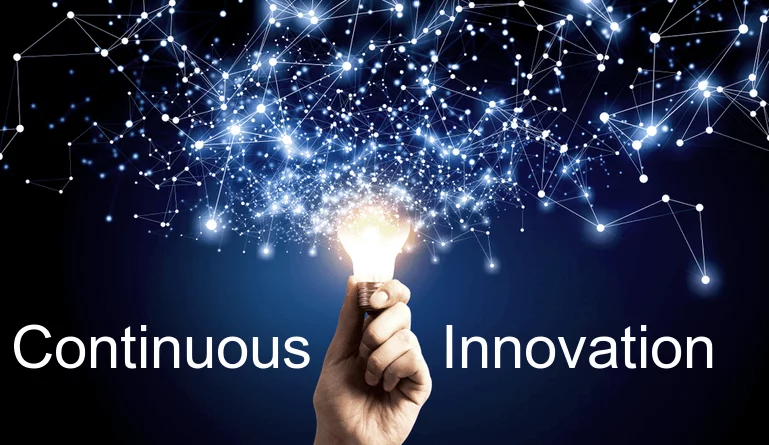If you’re involved in the business at any level, you’ve no doubt heard the term continuous innovation at one time or another. Because our world is constantly evolving, it’s impossible for a business to remain successful if the products and/or services they offer are stagnant.
Consumers want to know that the latest model of a technological device, for example, is the most up-to-date version of that minor upgrades that can be made to their vehicle when needed.
When a company is seriously involved in continuous innovation, they are more likely to see increased brand loyalty with consumers eagerly waiting to see what’s next. This will not look the same for every business, of course.
But Apple is a wonderful example of continuous innovation done right. Every few years, the legendary technology brand launches new and upgraded iPhones, along with other products in between, that excites its loyal (and still growing) customer base while also driving sales for the company.
Introduction to Product Innovation
Before continuous innovation can begin to take place, however, product innovation must happen first. A company must introduce a new product or service. If there is a high demand from the public for that product or service, the company should then launch a continuous innovation strategy for that product or service to ensure a recurring demand for it.
Gordon Tredgold, Founder and CEO of Leadership Principles, lists four important reasons(1) companies need to focus on innovation: fast growth, ability to stand out from competitors, ability to meet customer needs and ability to attract the best talent.
Results from The Deloitte Innovation Survey 2015(2) found that sixty-six percent of respondents stated innovation is important for business growth.
“Innovators predict changes in the market and provide solutions before people even realize they need them,” Tredgold writes. “You cannot meet your customers’ needs on a long-term basis unless you are willing to innovate. If you remain stagnant, your business will eventually flounder.”
What is Continuous Innovation?
Continuous innovation is when a company makes a constant improvement to the products, services, or technologies that they are responsible for. This improvement does not radically change the product, etc.; neither does it radically change the buying habits or usage patterns of that company’s customers. This must be done dynamically and continuously to save time, increase effectiveness, and maintain customer loyalty.
Types of Innovations
In business and life in general, there are many types of innovations that are often discussed and implemented by leaders, influencers, and the like. But the four major types of innovation are:
-
Incremental innovation
(Also called sustaining innovation, continuous innovation, dynamically continuous innovation, etc.).
-
Disruptive innovation
(Also called discontinuous innovation, etc.).
-
Architectural innovation
(Also known as basic research, etc.).
-
Radical innovation
(Also called breakthrough innovation, etc.).
As you can see, the different types of innovations go by many names but all in all they’re the same.
The opposite of continuous innovation is discontinuous innovation. Also known as radical innovations or disruptive innovations, this is when a company launches a new product or service that is completely different from a previous product or service, leading to a major change in consumer habits. This major change can either be negative or positive.
The third one, architectural innovation, basically takes existing skills and technology from one market and applies it within a different market. “This innovation is amazing at increasing new customers as long as the new market is receptive,” Jorge Lopez explains. “Most of the time, the risk involved in architectural innovation is low due to the reliance and reintroduction of proven technology. Though most of the time it requires tweaking to match the requirements of the new market.”
Radical innovation is something that eliminates an existing product, service, or company (consider how digital photography basically destroyed Kodak) or gives birth to a completely new product, technology, or industry (consider the invention of the airplane).
Also Download – Whitepaper ( Continuous Product Innovation and Differentiation )
Process of Continuous Innovation
The continuous innovation process will look different for every company, but eight steps can generally be followed.
-
Focus
This step focuses on the end result that is wanted. It involves developing short term and long-term outcome-based goals.
-
Explore
This step involves finding ways and necessary tools to achieve the goals that were developed in step one. Many different options and ideas should be introduced in this step, but none should be eliminated.
-
Select
This is the step when all options and ideas introduced in step two are considered. The best ones should be thought out further and the not so good ones should be set aside.
-
Design
This step involves designing the necessary action that is needed to implement the options decided upon in step three. Measures that track performance should also be implemented.
-
Action
This step is about staying on track with the activities designed in step four and measuring how well it performs.
-
Assess
This step involves assessing how well the action is helping achieve the goals given in the first step. Is the action working? If so, great! If not, what new action needs to be taken? Are there any unexpected problems that came up that need to be addressed?
-
Create
Creativity needs to be used in this step to come up with even more ideas for continued improvements.
-
Re-focus
In this step, we’re circling back to the beginning. It’s time to consider the end result and develop new goals.
Continuous Innovation Example
Gillette’s launch of Mach III after Mach II is an example of a company that used continuous innovation successfully.
In the anatomy of the brand’s global launch, Glenn Rifkin observes(3):
Sales of the Mach 3 have far surpassed Sensor and Sensor Excel, which both dominated the market in their day and have exceeded even Gillette’s lofty expectations. Despite the skepticism of some in the financial press, who felt the new razor was gimmicky and too expensive, in just six months Mach 3 has become the top-selling razor and blade in North America and Europe.
Gillette did not hurt or lose its existing customer base with the launch of a new razor. If anything, it excited them and probably kicked their loyalty up a few levels. This is what every company should aim for when using continuous innovation.
Advantages of Continuous Innovation
Continuous innovation requires a lot of work, but it has many advantages. Nawras Skhmot says, “Before starting a continuous improvement program it is important to understand the benefits of it. Knowing the benefits of the process can provoke action, allow for proper allocation of resources, and inspire everyone to put in the hard work necessary to pull off a successful program.”
-
Increased productivity
Continuous innovation requires that employees be more engaged, and the more employees are engaged, the more their productivity will increase. Several studies have shown that companies, where employees are highly engaged, earn significantly more income than their less-engaged peers.
Continuous innovation encourages employees to solve problems and empowers them to come up with ideas that will improve work process efficiency. When employees know their suggestions are important, considered, and tested, they will quickly switch from being passive observers to active participants.
-
Business growth
When small positive changes are made on a regular basis, companies will be able to improve quality, reduce mistakes, deliver orders accurately and increase profit. These are all steps that lead to business growth.
-
Better customer service
Customers love to hear that a company is always working to provide them with the best product or service, and this is exactly what continuous innovation promises. “Continuous improvement,” Skhmot writes, “provides a framework for identifying customer values and for minimizing waste in the value delivery process … This will lead to products and services that ‘anticipate’ the needs of customers even before they know they need themselves.”
Improved quality, lowered costs, increased employee satisfaction, and morale, and reduced employee turnover rate are also advantages of continuous innovation.
Challenges with Continuous Product Innovation
Good things don’t come challenge free and continuous innovation is no different. There are three main challenges that often come alongside this process.
Companies often operate at a breakneck speed and understandably so, but effective continuous change demands a slowing down. Managers often cite a lack of time or attention to consider innovation. Beware of being so busy or so comfortable that you keep things the way they are.
Innovation requires risk. For small or midsize companies that don’t have that much to lose, this might not be as big a deal. For larger and more established companies, however, that have a lot on their plate is might seem safer to stick with the norm than branch out and try something new. The risk may not always be greater than the reward, but it is certainly always better than regret.
The third main continuous innovation challenge is having too few or too many ideas. Having too few results in no innovation being done. Having too many leads to innovation going nowhere. A company must have an effective, streamlined process for brainstorming, choosing, creating, and doing.
Difference Between Continuous Innovation & Discontinuous Innovation
Dave Lavinsky gives two wonderful examples of continuous innovation and discontinuous innovation:
McDonald’s The Big Mac is an example of continuous innovation. This iconic multi-level burger made with a signature sauce has been a part of McDonald’s menu since 1968. Almost every year, new products are added to the menu and some old ones may be removed, but The Big Mac remains.
“This is a perfect example of how consistency can breed success,” Lavinsky writes. “Over the years, the marketing has changed and the process for creating the burger has been updated. The packaging may be different, but the basic product is still the same as it was over 45 years ago.”
Coca-Cola’s New Coke is an example of discontinuous innovation. During the 1980s, in an effort to compete with its main rival Pepsi, Coke decided to create a new formula completely different from the taste of its primary soda. As New Coke was rolled out into stores, what do you think happened? Did consumers embrace it? No. Completely the opposite happened.
“The response by consumers was exceedingly negative,” says Lavinsky. “Coke received hundreds of thousands of calls and letters, advocacy groups were created, faithful Coke drinkers stockpiled cases of the original Coke, and there were even lawsuits filed.”
Coke’s new soda formula was a negative change because the company failed to realize just how much their customer base had come to rely on the original taste of Coke. After much controversy, Coca-Cola re-released the original formula and Lavinsky writes that sales of Coke Classic were much higher than expected.
Every company should make use of continuous innovation by making incremental, modest, ongoing updates to existing technologies, services, or products. These updates should also be made to existing business processes, operations, and activities so that employees are continually becoming better and more efficient at their work.
Continuous innovation keeps a company from becoming complacent and static. Because it is continually innovating, it is always ahead of the game and on the cutting edge of what may be next. According to UC San Diego: “The majority of innovation happens at the incremental level, and when done deliberately, it drives organizations forward one project, change, and idea at a time. It occurs across all levels and all functions in an organization.”
It may or may not be necessary for companies to engage in discontinuous innovation. As we see in the example above from Coca-Cola, the major change they sought to bring about resulted in a huge negative controversy for the company and plenty of upset consumers.
Before doing away with or changing a product, technology or service that has a consistent strong demand, companies should be in touch with their customer base (e.g. take surveys, hold focus groups, respond to testimonials and feedback).
If the majority of customers are receptive to a major change, then the company should pursue its discontinuous innovation strategy. If only a minority of customers are on board with major change, the company should consider holding off or pursue something else.
Frequently Asked Questions about Continuous Innovation
Q. What are some of the largest factors for a firm when it demands continuous product innovation?
A. When a company considers continuous product innovation, there are several factors that should be kept in mind. First, management needs to be on board and committed to the process of continuous innovation.
This ensures that the necessary support that is needed, such as time and budget, will be available to those involved in the innovation process. Second, a culture that supports innovation must be built.
When employees step forward with new ideas and unique suggestions, they ought to be applauded and not shot down. Innovation should be communicated. Those who encourage innovation should be awarded.
Resources and space should be allowed for innovation. Third, all employees should be involved in the innovation process. You never know who may come up with the next big idea.
Q. Can a business survive long term with only continuous innovation?
A. Continuous innovation is integral to a company’s long-term success, but it is not the only important factor. Other processes and solutions need to be put in place, as well.
Q. Is continuous innovation better than continuous improvement?
A. No. It has not been proven that continuous innovation is better than continuous improvement. Both are necessary. One is not greater than the other.
Q. How can you promote continuous innovation within your organization?
A. Companies can promote continuous innovation within their organization just like they would any other process. Constant communication, incentives, training courses, and competition are just a few ways it can be promoted.
Q. Is continuous innovation too risky?
A. Almost every business act can be described as risky. It wouldn’t be business, otherwise. Continuous innovation is no riskier than product development, client onboarding, or process improvement.
Final Thoughts
Due to an increasingly borderless world and global competition, organizations must constantly be innovating their people and products to remain relevant. Continuous innovation is one of the best ways to get this accomplished.
Other Useful Resources:
Establishing an Effective Operating Model for Business Process Transformation





